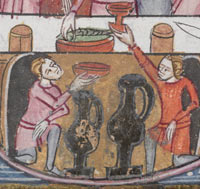 |
 |
 |
 |
 |
 |
 |
|
|
Fisheries and fishing rights: the example of Fountains Fish was an important part of the monastic diet, especially during Advent and Lent, when the use of animal fat, eggs, milk and milk products was either prohibited or restricted. Fountains, like other Cistercian communities therefore required a considerable amount of fish to provide for the monks and lay-brothers of the house, as well as for guests.Accordingly, the community secured rights to fish in rivers and along the coast, for example at Tessmouth, and the monks created fish ponds (stews) for freshwater fish. Several of these ponds are recorded in the inventory taken at the Dissolution and include 'Pondgarth', within the precinct, and two ponds known as 'Great Dene' and 'Little Dene' in Fountains Park.(1) Fish ponds within the abbey precinct were generally used for storage rather than for breeding.(2)
Gifts of fish were also received from benefactors, as well as from tenants, as part of the rental agreement. In addition, the community bought fish at markets. In the fifteenth century stockfish, often known as 'Icelandic fish', was bought at Hull, York and Scarborough. This was salt cod or ling that was usually salt-dried and imported from Iceland and Norway.(3) The accounts for 1457-1458 reveal that 13s 4d was spent on stockfish that year.(4) |
